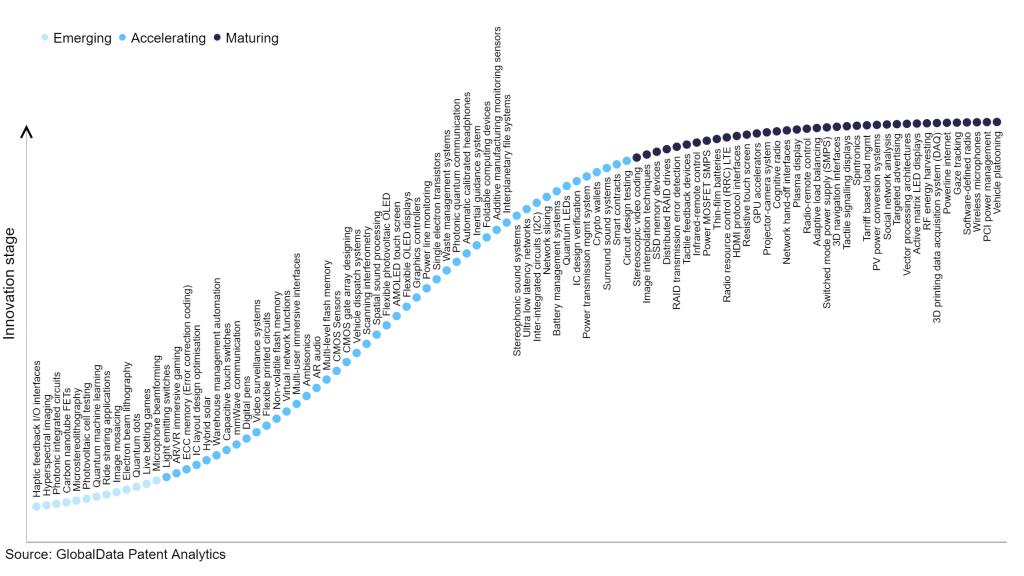The technology industry continues to be a hotbed of innovation, with activity driven by the increasing complexity and size of modern integrated circuits (ICs), the need for faster time-to-market and reduced design cycles, and the demand for enhanced quality and reliability of semiconductor devices, as well as growing importance of technologies such as simulation tools, formal verification methods, emulation platforms, and hardware-assisted verification techniques. Advancements in machine learning and artificial intelligence are being leveraged to automate and optimise the verification process, enabling more efficient and accurate identification of design issues. In the last three years alone, there have been over 3.6 million patents filed and granted in the technology industry, according to GlobalData’s report on Technology Innovation: IC design verification. Buy the report here.
However, not all innovations are equal and nor do they follow a constant upward trend. Instead, their evolution takes the form of an S-shaped curve that reflects their typical lifecycle from early emergence to accelerating adoption, before finally stabilising and reaching maturity.
Identifying where a particular innovation is on this journey, especially those that are in the emerging and accelerating stages, is essential for understanding their current level of adoption and the likely future trajectory and impact they will have.
300+ innovations will shape the technology industry
According to GlobalData’s Technology Foresights, which plots the S-curve for the technology industry using innovation intensity models built on over 2.5 million patents, there are 300+ innovation areas that will shape the future of the industry.
Within the emerging innovation stage, microphone beamforming, live betting games, and quantum dots are disruptive technologies that are in the early stages of application and should be tracked closely. Circuit design testing, communication, smart contracts, and surround sound systems are some of the accelerating innovation areas, where adoption has been steadily increasing. Among maturing innovation areas are vehicle platooning and pPeripheral cComponent iInterconnect (PCI) power management, which are now well-established in the industry.
Innovation S-curve for the technology industry

IC design verification is a key innovation area in technology
IC design verification refers to the crucial process of confirming the functionality of an integrated circuit (IC) design to ensure its adherence to specified requirements. This involves employing a range of tools and techniques to thoroughly test the chip design and assess its performance against predetermined specifications. Verification encompasses diverse analyses, including fault simulation, timing analysis, power analysis, and other relevant evaluations.
GlobalData’s analysis also uncovers the companies at the forefront of each innovation area and assesses the potential reach and impact of their patenting activity across different applications and geographies. According to GlobalData, there are 180+ companies, spanning technology vendors, established technology companies, and up-and-coming start-ups engaged in the development and application of IC design verification.
Key players in IC design verification – a disruptive innovation in the technology industry
‘Application diversity’ measures the number of different applications identified for each relevant patent and broadly splits companies into either ‘niche’ or ‘diversified’ innovators.
‘Geographic reach’ refers to the number of different countries each relevant patent is registered in and reflects the breadth of geographic application intended, ranging from ‘global’ to ‘local’.
Patent volumes related to IC design verification
Source: GlobalData Patent Analytics
Halliburton is a leading patent filer in IC design verification. One of the company’s patents focuses on systems and methods for simulating seismic-wave propagation in tilted transversely isotropic (TTI) media using an adaptive Lebedev staggered grid. The adaptive grid consists of multiple horizontal zones with different grid spacings based on a vertical wave-velocity model. The simulation involves solving finite-difference equations with spatially varying coefficients based on the grid spacing.
Other prominent patent filers in the space include Furukawa and Dassault Systemes.
By geographic reach, Ledaflow Technologies leads the pack, followed by 4energy and Halliburton. In terms of application diversity, Blue Sail Medical holds the top position, followed by General Dynamics and Vestas Wind Systems.
Integrated circuit design verification is a critical process in the semiconductor industry that involves validating and ensuring the correctness of the design of integrated circuits before fabrication. It encompasses various techniques and methodologies to detect and eliminate design flaws and functional errors, ensuring the functionality and reliability of the final product.
To further understand the key themes and technologies disrupting the technology industry, access GlobalData’s latest thematic research report on Technology.
Data Insights
From

The gold standard of business intelligence.
Blending expert knowledge with cutting-edge technology, GlobalData’s unrivalled proprietary data will enable you to decode what’s happening in your market. You can make better informed decisions and gain a future-proof advantage over your competitors.







